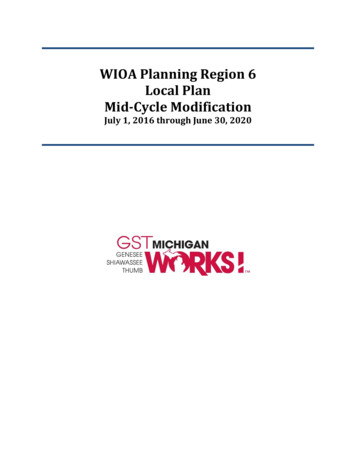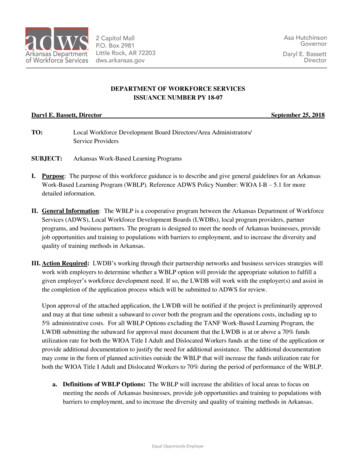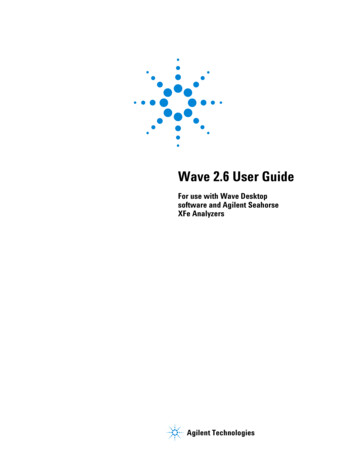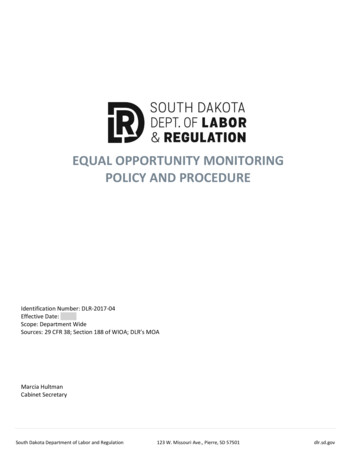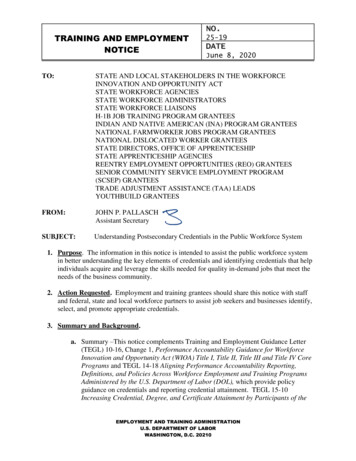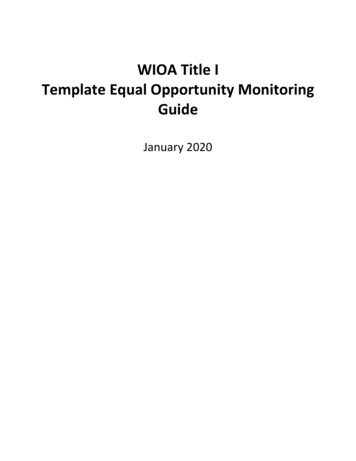
Transcription
WIOA Title ITemplate Equal Opportunity MonitoringGuideJanuary 2020
Table of ContentsIntroduction . 3I.II.III.Requirements of Monitoring Guidance . 3A.Minimum Elements for Each Review . 4B.EO Monitoring Requirements . 4C.EO Monitoring Tools . 4D.Elements of the Monitoring . 51.Desk monitoring review: . 52.On-site monitoring review: . 5Components of the Monitoring Process . 5A.Notification Letter and Monitoring Tools . 5B.Desk Review . 5C.On-Site Review . 5D.Exit Conference . 6E.Initial Determination Letter . 6F.Follow-up – Findings of Noncompliance . 7G.Final Determination . 7H.Sanctions . 7I.Appeals . 8Component Guidance . 8A.Data Analysis . 81.Statistical Analysis Process . 92.Service Area Demographic to Demographic Served Analysis . 93.Registered to Enrolled Statistical Analysis . 10B.On-Site Employee Interviews . 10C.Participant File Review . 11D.ADA Physical Access Review . 112
IntroductionThe National Association of State Workforce Agencies’ Equal Opportunity Committee has developed this guide to helpstates conduct Equal Opportunity monitoring in accordance with the equal opportunity and nondiscriminationprovisions of the Workforce Innovation and Opportunity Act (WIOA) of 2014. This is a template which can provide abasis for states as they develop monitoring processes for their individual states. 1The purpose of monitoring entities receiving WIOA Title I funding is to ensure compliance with WIOA section 188 and 29CFR 38, including a determination as to whether each recipient is conducting its WIOA Title I-financially assisted programor activity in a nondiscriminatory way. Section 188 of WIOA prohibits discrimination by recipients of federal financialassistance against any individual in the United States on the basis of race, color, religion, sex (including pregnancy,childbirth, and related medical conditions, sex stereotyping, transgender status, and gender identity), national origin(including limited English proficiency), age, disability, or political affiliation or belief, or, against any beneficiary of,applicant to, or participant in programs financially assisted under Title I of WIOA, on the basis of the individual’scitizenship status or participation in any WIOA Title I-financially assisted program or activity. Any entity that receivesfederal financial assistance, either directly or indirectly, to administer a program or activity under WIOA Title I is arecipient.Programs and activities funded in whole or in part by WIOA are subject to the following equal opportunity (EO) laws,regulations and policies: Title VI, Civil Rights Act of 1964Age Discrimination Act of 1975Rehabilitation Act of 1973, Section 504Title IX, Education Amendment Act of 197229 Code of Federal Regulations Part 38State Nondiscrimination PlanOther federal laws impacting the operations of state and local-level WIOA programs include, but are not limited to, thefollowing: Title VII, Civil Rights Act of 1964Age Discrimination in Employment Act of 1967Americans with Disabilities Act of 1990, as amendedRehabilitation Act of 1973, Section 501 and 503I.Requirements of Monitoring GuidanceMost review processes include two types of reviews, desk review and onsite review. A full review wouldinclude an initial desk review followed by an onsite review. A review may also include just a desk review.Federal law requires each entity receiving WIOA title I funding to be reviewed annually. It is up to each stateto develop a review process that defines frequency and types of reviews. Here are a couple examples:1. The EO officer will conduct a full review (desk and onsite) of every entity receiving WIOA Title I fundingon an annual basis.1This Guide is informational only and may not be relied on as legal advice.3
2. The EO Officer will schedule desk reviews of each one-stop center and subrecipient on an annual basis.A full desk and on-site review will be conducted once every three (3) years, unless a complaint isreceived or a desk audit indicates the need of an immediate on-site review.When determining the process for monitoring, consider resources available to the State and the risk level ofeach entity receiving WIOA Title I funding.A. Minimum Elements for Each ReviewAt minimum, each monitoring review will include:1. A statistical or other quantifiable analysis of records and data kept by the recipient under 29 CFR 38.51 (b) (1),including analyses by race/ethnicity, limited English proficiency, preferred language, sex, age, and disabilitystatus;2. An investigation of any significant differences identified in paragraph 1. of this section in participation in theprograms, activities, or employment provided by the recipient, to determine whether these differences appearto be caused by discrimination. This investigation must be conducted through review of the recipient’s recordsand any other appropriate means; and3. An assessment to determine whether the recipient has fulfilled its administrative obligations under section 188or this part (for example, recordkeeping, notice and communication) and any duties assigned to it under theNDP.B. EO Monitoring Requirements1. Each EO monitoring review shall include a review of each one-stop center and subrecipient:a. Compliance with its administrative obligations under WIOA section 188 and 29 CFR 38;b. Compliance with responsibilities it has been assigned through the NDP;c. Programs and activities to determine whether discrimination is occurring.2. Such monitoring review shall include a statistical or other quantifiable analysis of data and records collected bythe recipient and subrecipients, including analyses by race/ethnicity, sex, age, and disability status, pursuant to29 CFR 38.51. The monitoring must also include an investigation of any significant differences identified inparticipation in the programs, activities, or employment provided by the recipient to determine whether thesedifferences appear to be caused by discrimination. This investigation must be conducted through review of therecipient’s records and any other appropriate means.3. Both desk and on-site monitoring reviews will assess each recipient’s compliance with 29 CFR 38 related to:(i)Assurances (Sections 38.25 through 38.27);(ii)Equal Opportunity Officers (Sections 38.28 through 38.33);(iii)Notice and Communication (Sections 38.34 through 38.39);(iv)Data and Information Collection and Maintenance (Sections 38.41 through 38.45);(v)Affirmative Outreach (Section 38.40);(vi)Governor's Oversight Responsibility Regarding Recipients' Recordkeeping (Section 38.53);(vii)Complaint Processing Procedures (Sections 38.72 and 38.73); and(viii)Governor's Oversight and Monitoring Responsibilities for State Programs (Sections 38.51 and 38.53).C. EO Monitoring ToolsEach state should develop a monitoring tool to assist in all reviews. The tool should cover the elements listed in partB. 3. of this section. Example templates of these tools can be found in Appendix I a. and b. Appendix I a. Monitoringtool from South Dakota, which is a single service State, is prepared by changing all the text to part B of each Element4
to white and restricting editing to just fillable prior to sending to the entity under review. Appendix I b. is fromWashington State, which is a multi-service State.The purpose of developing a tool is to standardize the process of the review by having a set of question developedto gather information from the entity under review. It also helps determine the area the reviewer should focus moreon during the desk and/or on-site review.D. Elements of the MonitoringBelow is an example how a desk and onsite review can be structured.1. Desk monitoring review:i.ii.iii.iv.v.Notification Letter – Including Monitoring ToolsStatistical Analysis – Desk ReviewExiting Conference – Review any concerns, findings, or promising practicesMonitoring Report – Report of resultsFollow-up – Corrective Actions/Sanctions and resolution2. On-site monitoring review:i.ii.iii.iv.v.vi.II.Notification Letter – Including Monitoring ToolsStatistical Analysis – Desk ReviewOnsite ReviewExiting ConferenceMonitoring Report – Report of resultsFollow-up – Corrective Actions/Sanctions and resolutionComponents of the Monitoring ProcessA. Notification Letter and Monitoring ToolsThe notification letter announces the details and scope of the review and should include the monitoring tool for theentity to complete and return. Each State should have a standard timeframe established when the letter should besent to the entity under review to allow adequate time to prepare for review and complete the monitoring tool.Examples of time frames would be 30 days prior and 40 days prior to the on-site review. The letter should includeinstructions for the monitoring tool(s) and all applicable supporting documents requested, including when the tooland documents are due.B. Desk ReviewThe desk review should include reviewing case files, the completed monitoring tool and submitted supportdocuments, conducting a data analysis, and reviewing any other pertinent information available. During a fullreview, the desk review helps identify areas of focus for the on-site review. When the desk review is the standalone review process, it is used to determine compliance and formulate the report as well as determine ifadditional actions/efforts are needed (e.g., need to further review and conduct an on-site review).C. On-Site ReviewThe focus of the on-site review is to determine compliance with equal opportunity and nondiscriminationrequirements and to review significant differences or disparities identified during the desk review. It isrecommended, upon entering the site, the reviewer meet with the appropriate EO Coordinators/Administrator todiscuss the scope of the review, make arrangements for client and staff interviews or file reviews, and discusspreliminary findings.5
The following are areas of emphasis during the on-site review:a. Staff composition;b. Management and client interviews;c. Staff awareness of nondiscrimination and EO laws;d. Complaint files (if appropriate);e. Participant files;f. Physical aspects of the site — programmatic and architectural accessibility;g. Observance of reception, intake, and assessment processes, if applicable;h. Maintenance of EO policies and complaint files;i. Interviews with community-based organizations (when complaints or concerns have been identified orexpressed);j. Agreements with local organizations to provide needed services to persons with special needs; andk. Display of announcement, mandatory WIOA "Equal Opportunity is the Law" posters, and posters and signs forclients with limited English-speaking abilities.l. Follow up with monitoring tool On-site questions and concernsD. Exit ConferenceImmediately following the review, the reviewer may conduct an exit meeting with the appropriate EOCoordinator/Administrator or designee to discuss the findings and clarify areas in question. A preliminarycompliance status may be given at this time, and corrective action(s) may be suggested. This gives the entity underreview an opportunity to hear the initial findings, concerns, or promising practices and provide any additionalinformation relevant to making the final decision.E. Initial Determination LetterAt the conclusion of the monitoring review process, an "Initial Determination Letter" shall be written by the EOOfficer conducting the review. Each State should establish an adequate timeframe for when the report should becompleted and sent to the entity under review from the date of the On-Site review. An example would be 30 daysor 40 days from the date of the on-site review. Copies of the report shall be distributed to the recipient'smanagement. A copy shall be maintained by the local EO Officer conducting the review.a. Name, location, and contact information of the recipient reviewed;b. A brief description of the services or program provided by the recipient;c. Name and contact information of the EO Officer conducting the review;d. Reason(s) for the review;e. Results of any analytical data;f. Names of staff interviewed;g. Names of participants interviewed;h. Overall results of the review;i. Any findings of noncompliance including condition, cause, and criteria;j. Sanctions or corrective actions called for; and,k. Method and time frame for follow-up.In areas of noncompliance, the reviewer shall make required corrective action(s) in the report.Each State should establish a timeframe for entities to respond – example: thirty (30) days of the daterecommendations are received.States should establish a process for the scenario where an entity disagrees with the findings and/or correctiveaction. An example would be:6
If management disagrees with corrective action, management shall contact the reviewer to attempt an informalresolution of the issue(s).a. Where an informal resolution is reached, an implementation plan shall be forwarded to the reviewer withinthirty (30) days of the date recommendations are received.b. Where an informal resolution is not reached, the entity shall note their comments in their response andresolution will follow the Appeals Process.F. Follow-up – Findings of NoncomplianceIf the investigating authority finds reasonable cause to believe the recipient has violated the nondiscrimination andequal opportunity provisions of WIOA, 29 CFR 38 during the initial compliance review, a follow-up shall beconducted by the reviewing officer regarding any corrective actions or sanctions.G. Final DeterminationEach state should outline a Final Determination process. Below is an example.a. If compliance cannot be secured by voluntary means, the EO Officer must either:i. Issue a Final Determination;ii. Refer the matter to a Staff Attorney with a recommendation that an appropriate civil action beinstituted; oriii. Take such other action as may be provided by law.b. A Final Determination must contain the following information:i. A statement of the efforts made to achieve voluntary compliance, and a statement that those effortshave been unsuccessful;ii. A statement of those matters upon which the parties continue to disagree;iii. A list of any modifications to the findings of fact or conclusions set forth in the Initial Determination,Notice to Show Cause, or Letter of Findings;iv. A statement of the subrecipients, contractors, and other service providers’ (such as eligible trainingproviders) liability, and, if appropriate, the extent of that liability;v. A description of the corrective or remedial actions the grant applicant or recipient must take to comeinto compliance;vi. A notice that if the grant applicant or recipient fails to come into compliance within 10 days of the dateon which it receives the Final Determination, one or more of the following consequences may result:a) After the subrecipients, contractors, and other service providers (such as eligible training providers)are given the opportunity for a hearing, its WIOA funds may be terminated, discontinued, orwithheld in whole or in part, or its application for such funds may be denied, as appropriate;b) The agency may refer the case to an attorney with a request to file suit against the subrecipients,contractors, and other service providers; orc) The agency may take any other actions against the subrecipients, contractors, and other serviceproviders provided by law.vii. A notice of the grant applicant’s or recipient’s right to request a hearing under the procedures describedin 29 CFR 38.111.viii. A determination of DLR, entity’s authorized signatory, and the violating subrecipient, contractors, andother service provider’s liability, if any.H. SanctionsEach State should have a process for Sanctions. Below is an example.a. If compliance has not been achieved after issuance of a Final Determination or a Notification of Breach ofConciliation Agreement, the Agency may apply sanctions or judicial enforcement as follows:7
i.After opportunity for a hearing, suspend, terminate, deny or discontinue the WIOA financial assistance,in whole or in part;ii. Refer the matter to the a staff attorney or CRC with a recommendation that an appropriate civil actionbe instituted; oriii. Take such action as may be provided by law.b. In addition to sanctions and judicial enforcement, if there is no voluntary compliance there may be adeferral of new grants. When the applicable hearing procedures have been initiated against a recipient, theAgency or the CRC may defer action on that recipient's applications for new WIOA financial assistance until aFinal Decision as required has been rendered. Deferral is not appropriate when WIOA financial assistance isdue and payable under a previously approved application. The following criteria are applied to determineNew WIOA financial assistance:i. New WIOA financial assistance includes all assistance for which an application or approval, includingrenewal or continuation of existing activities, or authorization of new activities, is required during thedeferral period.ii. New WIOA financial assistance does not include assistance approved before the beginning ofproceedings, or increases in funding because of changed computations of formula awards.I. AppealsEach State should have an appeals process. Below is an example.If an entity under review disagrees with the Final Determination letter, they must appeal in writing to the(Governors designee for EO) requesting a hearing within 30 days of the date of the final determination. The appealletter must identify the issue(s) in dispute and must contain a full statement of the entities’ position with respect tosuch issue(s) and the pertinent facts and reasons in support of their position. In addition to the required writtenstatement, the entity must also provide copies of any documents supporting its claim. A copy of the request mustalso be sent the EO Officer who signed the final determination. Those portions of the final determination notspecified for review shall be considered resolved and not subject to further review.When no timely request for a hearing is made, the final determination shall constitute final action. The request fora hearing shall be accompanied with a copy of the final determination, if issued. The (Governors designee for EO)will review the appeal letter and determine whether the dispute is reviewable and will promptly notify thesubrecipient and the reviewer responsible for the final determination of the decision.If the (Governors designee for EO) determines the dispute is reviewable, a meeting will be set up to allow bothparties to discuss the pertinent issues of the dispute and provide any additional statements and documentation notprovided in the appeal letter. Based on the review, the (Governors designee for EO) will prepare a written decisionto send to the subrecipient. The decision made by the (Governors designee for EO) shall be final.III.Component GuidanceThis section provides additional guidance on key components of the review including data analysis,employee interviews, file review, and ADA reviewA. Data Analysis29 CFR 38.51 (b) (1) states in part that each annual monitor must include a statistical or other quantifiable analysisof records and data kept by the recipient under 29 CFR 38.51 (b) (1), including analyses by race/ethnicity, limitedEnglish proficiency, preferred language, sex, age, and disability status.8
Each State must develop a process for conducting a data analysis. Below is an example process for meeting thisrequirement.This example process involves two analyses. The first is Appendix II – Service Area Demographic to Served Analysis,which focuses on the effectiveness of getting the protected classes to participate in the services provided –outreach. The second is Appendix III –Enrolled in Wagner Peyser (WP) versus WIOA Analysis, which focuses on foottraffic and the effectiveness of getting protected classes the favored result – enrolled in WIOA. Both analyses arerevised versions of the Statistical Analysis Workbook provided by the CRC during the December 03, 2017 EOTraining and use standard deviation to determine the probability of discrimination by each category.Notes about standard deviations:a.b.c.d.e.The standard deviation analysis looks at the probability that the difference in rates is due to chance.Technically, this is a two independent sample binomial test.Differences greater than 2.0 standard deviations is generally what suggests possible discrimination.The 2.0 standard deviation represents a less than 5.0% chance that the difference in rates is due to chance.Another way to think about it is that if the SD is greater than 2.0, there is something that is controlling theprocess because there is less than 5% chance that the difference was caused by chance.1. Statistical Analysis ProcessEach of these statistical analyses do a standard deviation of two groups. The first group is the non-protectedclass and the second group is the protected class. You will need to collect data by each category (race, sex,disability status, LEP, and age) and fill in the blanks for each sheet in the Data Analysis Workbook. A result of 2 orgreater would indicate a probability discrimination is present and you would need to do some furtherinvestigation to make the final determination. Below is a breakdown of how to collect and use the data bothanalyses.2. Service Area Demographic to Demographic Served AnalysisThe purpose of this analysis is to determine if there is any indication of discrimination by race, sex, disabilitystatus, LEP, and age by comparing population demographic to population served. For this report, the reviewerwill need two sources of data. The first is the Census data showing the population demographic and the secondis the State’s data collection source showing the population served. Both sources of data will need to collectinformation by race, sex, disability status, LEP, and age.a. Collecting Census DataThe census data comes from American Fact Finder and there are three reports needed to collect the data byrace, sex, disability status, LEP, and age. For each report you will need to select “Add/Remove Geographies”to add the service area you are reviewing (by county). You can save the report by selecting“Bookmark/Save” and copy the URL (recommendation is to create a word document table with all yourentities and hyperlink each report into the documents for future use). The reports are:i.Profile of General Population and Housing Characteristics: 2010 more information 2010 DemographicProfile Data This report is to collect data by age, race, and sex.ii. DISABILITY CHARACTERISTICS more information 2013-2017 American Community Survey 5-YearEstimates This report is to collect disability status data.iii. NATIVITY BY LANGUAGE SPOKEN AT HOME BY ABILITY TO SPEAK ENGLISH FOR THE POPULATION 5YEARS AND OVER Universe: Population 5 years and over more information 2012-2016 AmericanCommunity Survey 5-Year Estimates This report is to collect LEP data.b. Organizing Census Data9
You will need to download each report as an Excel document (Recommendation – save all reports in oneExcel file as separate sheets – see appendix IV for an example. Below are the general steps for each report.i. 2010 Demographic Profile Data:1. Download each county for the service area as a “View” MS Excel file.2. Move all the sheets to one Excel file.3. Combine the data into one sheet.4. Create a sum column and sum all the totals for each category.5. Create a Table for Age (group 15-39 and 40-64 and sum both groups)6. Create table for Male and Female (sum each group with ages 15-64)7. Create a table for race (group 1 is White (non-protected class) and group 2 is the largest minorityclass in the serving area.ii. Disability Characteristics:1. Download data as “View” MS Excel document.2. Create a table summing the total disabled and non-disabled from age 18 to 64.iii. Nativity by Language Spoken1. Download as Excel file2. Delete all columns with margin of error.3. Highlight all numbers, in top left should be a small box with a ‘!’– click drop down and select“Convert to number”4. Create a total column and total all the amounts.5. To the right, create a table with the categories: LEP and Non LEP.6. Sum all “Not well” and “Not at all” in the LEP7. Sum all “speak only English”, “very well”, and “well” in the non-LEPc. Collecting Demographic Served DataEach State should have a method for collecting data by race, sex, disability status, LEP, and age. Generatethese reports for individuals who have been enrolled and receiving or received benefits. Save these reportsas a PDF.d. Completing the Data Analysis WorkbookThe Service Area Demographic to Served Analysis workbook has a separate sheet for each category (race,sex, disability status, LEP, and age). Input the data in the highlighted Excel cells (blue is the non-protectedclass; yellow is the protected class). Review the results of the standard deviation in the gray cell. If it is twoor higher, there is a probability discrimination exists and you will need to do further investigation.3. Registered to Enrolled Statistical AnalysisThe purpose of this analysis is to determine if there is any indication of discrimination by race, sex, disabilitystatus, and age by comparing registered only participants (unfavored result) to enrolled participants (favoredresult). For this analysis, a reviewer would need to be able to pull reports for registered only and enrolled byeach category (race, sex, disability status, LEP, and age). Use the data collected to complete the Registered toEnrolled Statistical Analysis Workbook (See appendix III).B. On-Site Employee InterviewsThe purpose of the onsite interviews is to evaluate employee’s knowledge and understanding of meeting therequirements of a State’s Non-Discrimination Plan, 29 CFR 38, and other applicable laws and regulations governingWIOA Title I programs. Each State EO reviewer should develop interview questions to ask staff during on-site10
reviews (see Appendix V a. and Appendix V b. for example templates). The questions should focus on testing theknowledge and understanding of implementing the requirements outlined in the Non-Discrimination Plan. Resultsfrom the interviews will help the reviewer determine areas of weakness and training opportunities. Areas to focuson include:i.ii.iii.iv.v.Providing equal services to LEPProviding equal services to individuals who are deaf, hard-of-hearing, deaf-blind, and or speech disabledDiscrimination Complaint ProcessCollecting Required EO dataFile Review (cover any concerns discovered during the file review)C. Participant File ReviewThe goal of
(viii) Governor's Oversight and Monitoring Responsibilities for State Programs (Sections 38.51 and 38.53). C. EO Monitoring Tools Each state should develop a monitoring tool to assist in all reviews. The tool should cover the elements listed in part B. 3. of this section. Example templates of these tools can be found in Appendix I a. and b.



